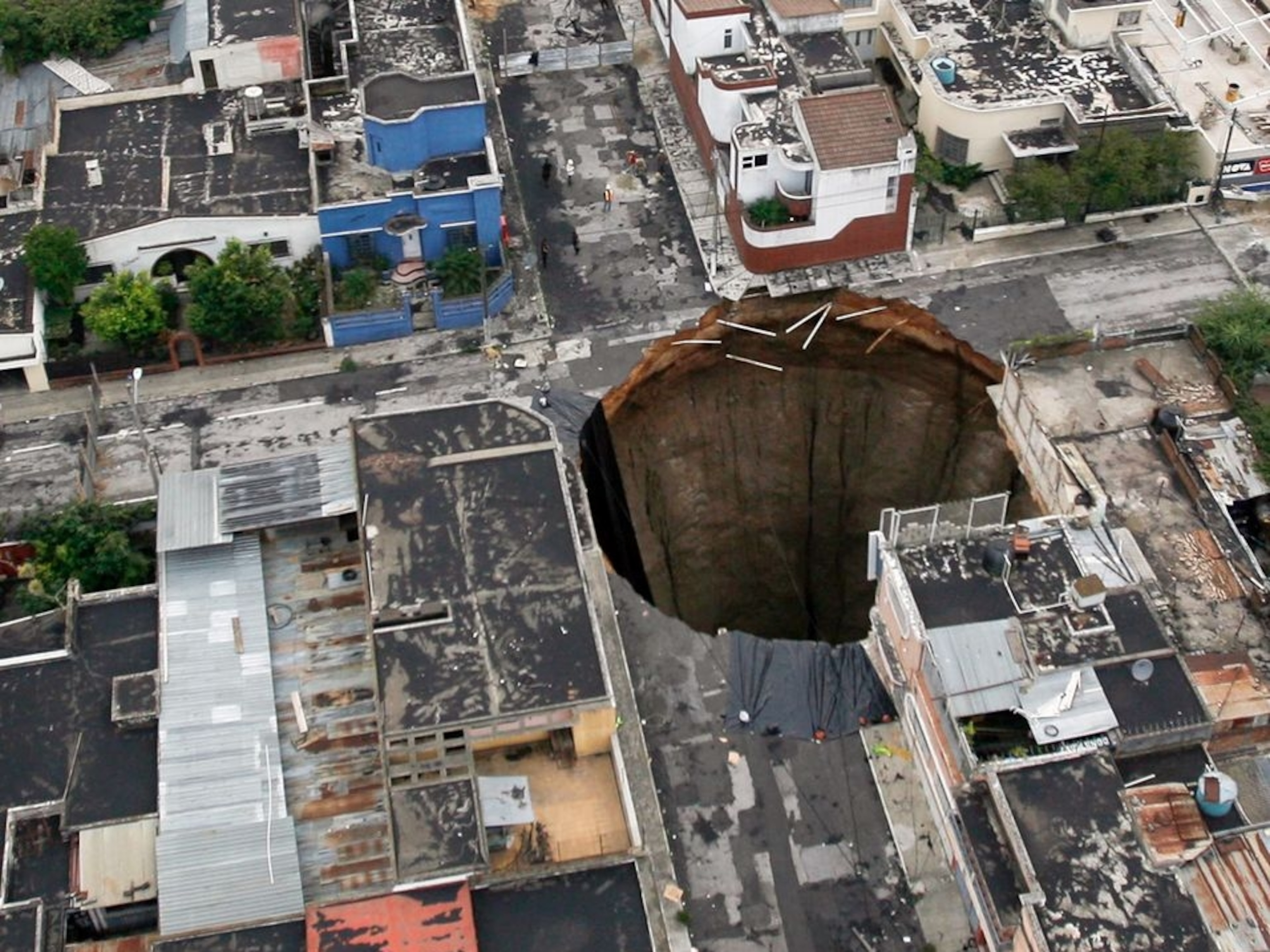Uncovering The Mysterious Depths: Exploring The Phenomenon Of Sinkholes
8 min read
Uncovering the Mysterious Depths: Exploring the Phenomenon of Sinkholes
Step right up, curious minds! Today, we embark on a thrilling journey into the enigmatic world of sinkholes. Brace yourself for an adventure that will take us deep below the Earth’s surface, where hidden dangers and captivating mysteries lurk. From their formation to the triggers that set them off, we’ll unravel the secrets behind these natural wonders.
Sinkholes have captivated our imaginations for centuries. These bizarre phenomena can appear seemingly out of nowhere, swallowing roads, buildings, and even entire landscapes in their voracious grasp. But what exactly are they? How do they form? And most importantly, how can we protect ourselves from their treacherous allure?
In this blog post, we’ll dive headfirst into sinkhole science (figuratively speaking!) as we explore everything you need to know about these intriguing geological features. So buckle up and get ready to delve into the depths with us as we uncover the truth behind sinkholes – a wild ride awaits!
What are sinkholes?
What are sinkholes?
Sinkholes, my friends, are nature’s very own trapdoors. Picture this: you’re strolling along a peaceful countryside or driving down a familiar road when suddenly the ground beneath you gives way! What was once solid terrain transforms into an ominous void that swallows everything in its path.
But let’s get technical for a moment. Sinkholes are depressions or cavities that form on the Earth’s surface due to the collapse of underlying rock or soil layers. They can range in size from small pits to massive chasms capable of engulfing entire buildings. These geological marvels come in various shapes and forms – some appear as smooth dips while others resemble gaping craters.
So how do these sinkhole portals come to be? Well, it all begins with water. Underground water sources slowly erode soluble rocks such as limestone and gypsum over time, creating hollow spaces underground known as “karst” landscapes. When the roof of these caverns becomes too weak to support the weight above, bam! A sinkhole is born.
While they may seem like creatures out of a fantasy novel, sinkholes have very real causes rooted in geology and hydrology. Stay tuned as we delve deeper into their formation process and uncover what triggers these mysterious collapses from beneath our feet.
How do sinkholes form?
How do sinkholes form? It’s a question that has intrigued scientists and geologists for centuries. To understand the formation of these mysterious phenomena, we must delve into the depths of our planet.
Sinkholes are essentially cavities or holes in the ground that form when underground rocks dissolve or collapse. One common type is known as a “dissolution sinkhole,” which occurs in areas with soluble rock such as limestone or gypsum. Over time, water seeps through cracks and crevices in the rock, eroding it from within. Eventually, this erosion weakens the surface layer, causing it to collapse and create a sinkhole.
Another type of sinkhole is referred to as a “cover-collapse sinkhole.” These occur when an underground void forms beneath the surface due to natural processes like erosion or groundwater movement. As the void grows larger over time, it puts pressure on the soil above until one day it collapses suddenly, creating a hole at the surface.
Human activities can also contribute to sinkhole formation. For example, excessive pumping of groundwater can lead to subsidence—a gradual sinking of land—and eventually result in sinkholes forming.
It’s important to note that not all areas are equally susceptible to sinkholes. Certain regions with specific geological characteristics—such as those with porous rock formations—are more prone to their occurrence.
Understanding how sinkholes form helps us grasp their potential danger and take necessary precautions. By monitoring changes in land elevation and addressing any signs of subsidence promptly, we can mitigate risks associated with these enigmatic phenomena.
Understanding how different types of sinkholes form involves examining geological factors such as soluble rocks and human-induced activities like excessive groundwater extraction. Being aware of these processes allows us to better protect ourselves from potential dangers lurking beneath our feet. So next time you walk on seemingly solid ground, remember that beneath lies an intricate world waiting for exploration—or perhaps even a hidden danger: a mysterious abyss known as a sinkhole.
What triggers a sinkhole to form?
What triggers a sinkhole to form? It’s a question that has fascinated scientists and geologists for years. Sinkholes are natural phenomena that occur when the ground beneath us gives way, creating a sudden depression or hole in the earth’s surface. But what exactly causes this dramatic event?
One of the main triggers for sinkholes is water. Over time, underground water sources can erode and dissolve certain types of rocks, such as limestone or gypsum. This process creates voids or cavities in the ground, weakening its structure. When enough material has been removed, the weight of the overlying soil becomes too much to bear and collapses into these empty spaces.
Another factor that can contribute to sinkhole formation is human activity. Construction practices like mining or drilling can disturb underground layers and alter their stability. Additionally, excessive groundwater extraction can cause land subsidence, which increases the likelihood of sinkholes forming.
Natural processes like heavy rainfall or prolonged droughts can also play a role in triggering sinkholes. Excessive rainwater can infiltrate into subsurface rock layers, increasing pressure on already weakened structures and potentially leading to collapse. Conversely, drought conditions may cause groundwater levels to drop significantly, further destabilizing underground formations.
It’s important to note that while certain geological features make an area more prone to sinkhole formation (such as regions with soluble rock formations), it doesn’t mean they will definitely occur there.
In conclusion. Oops! I almost slipped into concluding mode there! Let’s just say that understanding what triggers a sinkhole formation is crucial for both researchers and individuals living in susceptible areas alike. By studying these factors closely, we can better predict where potential dangers lie and take appropriate measures accordingly
The dangers of sinkholes
The Dangers of Sinkholes
Sinkholes are not just ominous geological formations; they can pose significant dangers to both people and property. One moment, the ground appears stable, and the next, it collapses into a gaping hole. These sudden events can catch anyone off guard, resulting in serious consequences.
Sinkholes can cause severe damage to buildings and infrastructure. As the ground beneath weakens or gives way completely, structures above may crumble or collapse entirely. This puts lives at risk and leaves behind a trail of destruction.
Furthermore, sinkholes can lead to injuries or even fatalities. Imagine walking along a path when suddenly the earth disappears beneath your feet! Falls into sinkholes have been known to result in broken bones, concussions, and worse.
In addition to physical harm, sinkholes also carry financial implications. Property values plummet as potential buyers become wary of the area’s unstable ground conditions. Insurance rates skyrocket for those living in regions prone to this geologic phenomenon.
Last but certainly not least important is the emotional toll that sinkhole occurrences inflict upon individuals and communities affected by them. The loss of homes or businesses can be devastating emotionally as well as financially.
It is crucial for homeowners residing in areas with a history of sinkhole activity to take preventative measures seriously. Regular inspections by professionals specializing in structural integrity can help detect early signs of instability before they escalate into full-blown disasters.
Being aware of any changes in the landscape such as depressions or cracks forming on walls should never be ignored either. Prompt reporting ensures that necessary actions are taken promptly minimizing risks associated with these dangerous phenomena.
While we cannot control Mother Nature’s whims entirely nor predict exactly where and when sinkholes will form next – being educated about their dangers empowers us all to make informed decisions regarding our safety and well-being
How to prevent sinkholes from forming in your home
When it comes to preventing sinkholes from forming in your home, there are a few important steps that you can take. First and foremost, it is crucial to maintain proper drainage around your property. This means ensuring that water flows away from your home instead of pooling near the foundation.
Regular inspections of the soil around your property can also help identify any potential signs of sinkhole formation. Look out for depressions or sinking areas, as well as cracks in the walls or floors of your home. If you notice any of these warning signs, it is important to seek professional advice immediately.
Another way to prevent sinkholes is by avoiding excessive water usage. Excessive pumping of groundwater can lead to subsidence and ultimately contribute to the formation of sinkholes.
Additionally, practicing responsible construction techniques is key. Building on stable ground and using appropriate engineering methods will help minimize the risk of sinkhole development.
Proactive measures such as maintaining good drainage, monitoring for warning signs, conserving water resources, and employing proper construction practices can greatly reduce the likelihood of sinkhole formation on your property. By taking these precautions seriously, you can ensure the safety and stability of your home for years to come!
Conclusion
Conclusion
Sinkholes are a natural phenomenon that can have devastating effects on both the environment and human structures. As we have explored in this article, sinkholes form when underground caves or voids collapse, creating sudden depressions in the ground. These collapses can be triggered by various factors such as erosion, excessive groundwater pumping, or even heavy rainfall.
The dangers of sinkholes cannot be ignored. They pose significant risks to infrastructure, property, and most importantly, human lives. Sinkhole-related incidents have occurred around the world throughout history, causing extensive damage and loss.
However menacing sinkholes may seem, there are ways to prevent them from forming in your home. Proper land management practices can help minimize the risk of sinkhole formation. Regular inspection of your property for signs such as cracks in walls or floors can also alert you to potential problems early on.
In areas prone to sinkhole activity, it is essential to consult with professionals who specialize in geotechnical engineering and construction techniques designed to mitigate these risks effectively.
While we cannot control natural geological processes entirely, understanding how sinkholes form and taking preventative measures can go a long way in protecting ourselves and our properties from their destructive power.
So next time you encounter a mysterious depression or hear about another unfortunate incident involving sinkholes – remember that knowledge is power! By staying informed about this fascinating yet dangerous phenomenon called “sinkholes,” you’ll be better equipped to navigate through life while keeping yourself safe from their unyielding depths.





